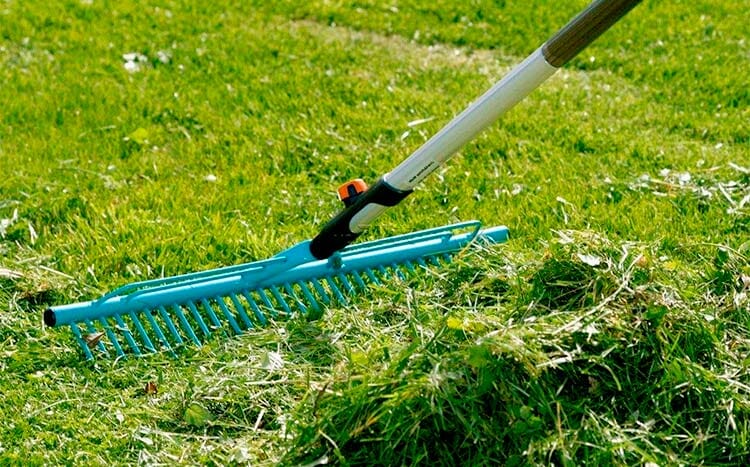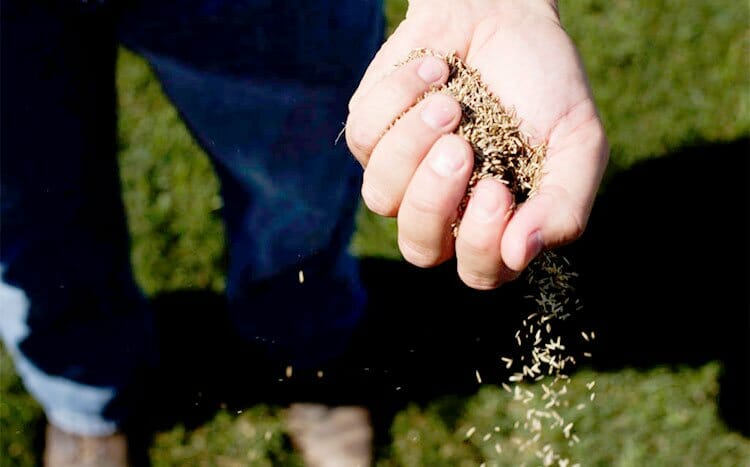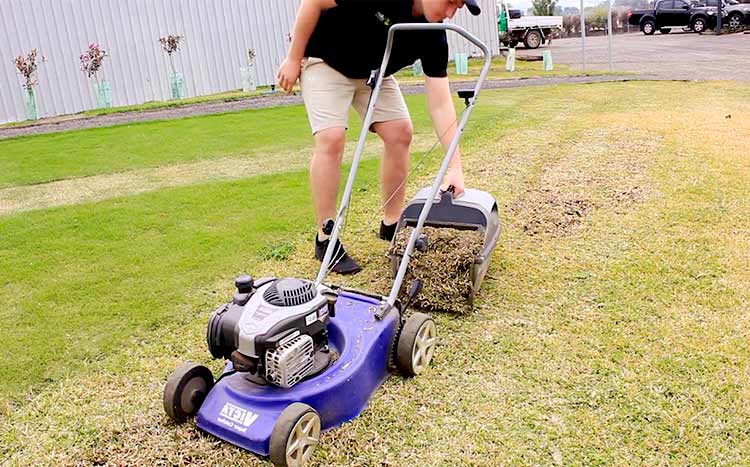Dethatching is a highly effective method to rejuvenate and improve the health of your lawn. When performed correctly, it can greatly enhance the aesthetic appearance of your lawn by improving the infiltration of essential elements such as nutrients, air, water, and fertilizer.
Dethatching grass helps it grow because it frees the grass from the strangling effect of a thick thatch layer. Through the dethatching process, the grass will be able to get deeper root penetration, its roots will be able to breathe a little bit more effectively, and moisture and nutrients will be able to reach deeper into the soil more freely.
And in cases where your grass is being attacked by diseases and fungi, the dethatching process will also give it the best odds of recovering since it will make it easier for the treatment to reach its roots.
Is dethatching or aeration better?

On a yearly basis, aeration is a better lawn care routine when compared to dethatching because it typically takes a lot of time for the thatch layer to build up to a point where it is detrimental to the health of your lawn. In fact, before your lawn’s thatch layer grows to over an inch in thickness, the thatch layer will be beneficial.
It will keep the soil from experiencing extreme swings in temperature. It will also serve as a moisture-conserving blanket since it usually reduces the rate at which moisture evaporates from the soil. Therefore, in the short term, dethatching is not only unnecessary, but it can in fact be detrimental to your lawn’s health.
Once the thatch layer has grown in thickness to a point where it is more than an inch thick, then dethatching will become more important than aeration. This is because no matter how frequently you aerate your lawn if the thatch layer is so thick that it is literally suffocating your grass, the grass won’t be able to take advantage of the extra space that aeration creates.
When should I dethatch?
You should dethatch your lawn once the thatch layer has grown to over an inch. In most cases, this happens after every 5 years, although it can happen as early as at the three-year mark.
Once you notice that water isn’t getting through into the soil when you are watering it, or your lawn is showing visible signs of weakness or malnutrition, then it is time to investigate whether thatch is to blame. To do so, simply cut off a small vertical section of your lawn about two inches deep, and then measure the thatch layer. If it is over three-quarters of an inch thick, then the thatch layer is a likely culprit.
How often do you dethatch?
As a general rule, you should dethatch your lawn at least once every five years. If you wait longer than this in order to dethatch, it might be too late for your lawn. And if you do it way more often than this, you may be subjecting your grass to needless trauma. You may even be robbing it of a protective layer that helps to regulate soil temperature and keep it from losing moisture.
As a result, waiting to do it after 5 years is a better bet as this is typically the point at which most lawns develop thatch layers that are thick enough to start causing problems.
However, it is important to note that depending on the type of grass that one has, and the rate at which he or she fertilizes and waters their grass, it is possible for the thatch layer to grow at a faster rate. Therefore, there are cases where dethatching after about 3 years, or even less, is necessary. This makes measuring the thickness of the thatch layer the most effective way of telling whether a lawn needs dethatching.
Should I seed after dethatching?
Yes, you should seed after dethatching. This is because, after the dethatching process, your lawn will be left with visible patches. These patches will give your lawn a ragged and unattractive look and seeding right after will give your lawn the best chance of getting back to its former shape.
Furthermore, after dethatching, seeds have a better chance of germinating and thriving. This is because the process removes the thatch, making it easier for the grass seeds to get in contact with soil. it gives the seeds better odds of survival as it makes it easier for their roots to receive air, fertilizer, and moisture. It also reduces the pest-habiting nature of thatch, something that will go a long way towards ensuring the survival of the growing grass shoots.

Is raking and dethatching the same thing?
No, raking and dethatching is not the same thing.
Raking involves using a rake to get rid of cut grass and other debris in order to make your lawn neat. On the other hand, dethatching involves using a dethatcher, or a specialized dethatching rake, to cut deep into the thatch layer with the aim of increasing the rate at which moisture, air, and nutrients get to the roots of your grass.
Dethatching is typically a once-every-five-years lawn maintenance routine, while raking is an activity that you can do every other day. This, in addition to the fact that the processes use different tools and that they feature varying degrees of intrusiveness, makes them completely different from each other.
How do you treat a lawn after dethatching?
After dethatching, the first thing that you should do is to remove the cut thatch from your lawn by raking it. After you are done, you will then have to fertilize the lawn and then make sure that it is regularly watered in order to ensure that you give your lawn the best chance of bouncing back. And if that thatching process leaves your lawn looking ragged and unattractive, then overseeding is something that you will have to consider.

Can Dethatching be a bad thing?
Yes, dethatching can be a bad thing. This is because thatch is useful to a lawn. It helps to keep the grass in good health by protecting it from extreme temperature fluctuations. It also ensures that grassroots have reliable access to moisture by reducing the rate at which soil loses moisture to the environment.
Dethatching essentially involves removing this layer. As a result, if the thatch hasn’t grown to a point where it is detrimental to a lawn’s health, it is always advisable that you hold it off.
Also, keep in mind that the dethatching process is traumatic to a lawn. It typically involves cutting through the lawn with heavy machinery. In the course of the dethatching process, it is therefore not surprising to see ugly-looking patches and injured grass. As a result, if the dethatching process isn’t timed properly, and if the grass isn’t given enough nutrients and moisture to recover, the dethatching process can end up causing irreparable harm.
Should I dethatch or aerate?
You should dethatch when your lawn’s thatch layer grows to over 1-inch, and you should aerate as soon as the soil in your lawn becomes compact. For aeration, simply take a screwdriver and push it through your lawn. if it does not get through the soil with ease, it is time for you to consider aerating the soil. As for dethatching, the surest way to tell whether it is necessary is to cut a small section of your lawn to about 2 inches deep and then measure the thatch layer. If it is not near the ideal thickness — about ½ an inch thick — then you should consider dethatching.
FAQ's
Do I need to dethatch?
No, for as long as your lawn is healthy and its thatch layer is less than ¾ inch thick, you don’t need to dethatch it. Dethatching is only necessary in cases where the thatch layer is so thick that it makes it difficult for the roots of the grass to receive nutrients, moisture, and air.
What's the dethatching cost per sq ft?
The dethatching cost ranges from $0.2 to 0.4 per square foot.
Do you mow after detaching?
No, you don’t mow after dethatching. It is typically done before dethatching as a way of making the dethatching process easier. And in such cases, mowing the lawn to ½ its normal height is recommended.
Will dethatching remove weeds?
No, dethatching does not remove weeds. if anything, it can make it easier for weeds to grow because it essentially makes it easier for things — this includes both grass and weeds — to grow on the lawn area.
Given the benefits that come with the dethatching process, it is a lawn care routine that every homeowner should prioritize. And in case one doesn’t have the time or expertise to dethatch their lawn, contacting a lawn care expert is a time-saving option that one can always explore.






